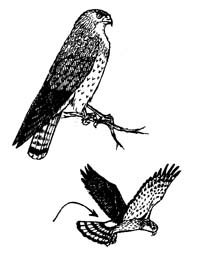

In the winter, they can be found from the southern U.S. to Central America. In the summer, they breed from Alaska, across Canada and down into the northern U.S.
They live in fields, prairies and marshes.
They are large hawks that have dark gray backs and wings with a white spotted chest and belly. They can be up to 24 inches tall. One of the ways they can be identified while flying over is that they have a bright white “rump patch” right above their gray tail.
They hunt by flying low over fields or marshes holding their wings up in a v-shaped pattern. They can hover in one place, but then dive on prey. They use their great hearing to help them find prey.
They eat small mammals, birds, and frogs.
Males may breed with many females. The females make a nest in the tall grass, higher up on dry ground. She lays 4-9 pale blue eggs and warms them (incubates) herself. The male will bring her food while she cares for the eggs and then the hatched babies.
Kingdom: Animalia
Phylum: Chordata
Subphylum: Vetebrata
Class: Aves
Order: Falconiformes
Family: Accipitridae/Subfamily: Accipitrinae
Genus: Circus
Species: C. cyaneus
When you research information you must cite the reference. Citing for websites is different from citing from books, magazines and periodicals. The style of citing shown here is from the MLA Style Citations (Modern Language Association).
When citing a WEBSITE the general format is as follows.
Author Last Name, First Name(s). "Title: Subtitle of Part of Web Page, if appropriate." Title: Subtitle: Section of Page if appropriate. Sponsoring/Publishing Agency, If Given. Additional significant descriptive information. Date of Electronic Publication or other Date, such as Last Updated. Day Month Year of access < URL >.
Amsel, Sheri. "Hawk (Marsh) - Northern Harrier" Exploring Nature Educational Resource ©2005-2024. December 13, 2024
< http://exploringnature.org/db/view/Hawk-Marsh-Northern-Harrier >

